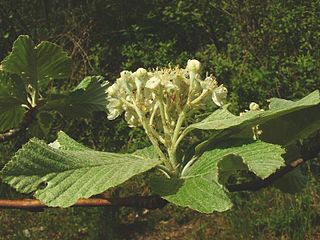
The whitebeams are members of the family Rosaceae, comprising the genus Aria. They are deciduous trees with simple or lobed leaves, arranged alternately. They are related to the rowans, and many of the endemic restricted-range apomictic microspecies of whitebeam in Europe are thought to derive from hybrids between the common whitebeam and the European rowan. Some are also thought to be hybrids with the wild service tree, and the service tree of Fontainebleau found in French woodlands.

The Botanical Society of Britain and Ireland (BSBI) is a scientific society for the study of flora, plant distribution and taxonomy relating to Great Britain, Ireland, the Channel Islands and the Isle of Man. The society was founded as the Botanical Society of London in 1836, and became the Botanical Society of the British Isles, eventually changing to its current name in 2013. It includes both professional and amateur members and is the largest organisation devoted to botany in the British Isles. Its history is recounted in David Allen's book The Botanists.
The Arran whitebeams are species of whitebeam endemic to the island of Arran, Ayrshire, Scotland.
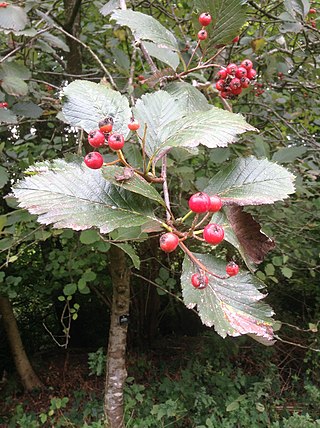
Hedlundia anglica, the English whitebeam, is a species of whitebeam tree in the family Rosaceae. It is endemic to Ireland and the United Kingdom, with an entire British population estimated at 600 individuals.

Hedlundia arranensis, sometimes referred to as the Scottish or Arran whitebeam, is a species of plant in the family Rosaceae. It is endemic to the island of Arran in Scotland.

Aria eminens, commonly known as the round-leaved whitebeam, is a species of plant in the family Rosaceae. It is endemic to Great Britain and is threatened by habitat loss.
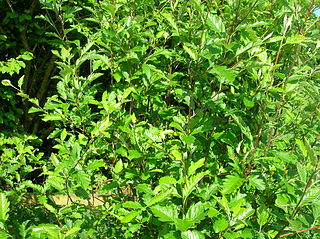
Hedlundia pseudofennica, also called Arran service-tree or Arran cut-leaved whitebeam, is a species of plant in the family Rosaceae. Endemic to the Isle of Arran in Scotland, it is threatened by habitat loss. It is thought to be a naturally occurring hybrid between H. arranensis and Sorbus aucuparia, probably with additional backcrossing with S. aucuparia. Hedlundia arranensis is itself a hybrid between Aria rupicola and S. aucuparia. Apomixis and hybridization are common in some groups of Sorbus species.

Karpatiosorbus subcuneata, the Somerset whitebeam, is a species of plant in the family Rosaceae. It is endemic to coastal north Devon and west Somerset in the United Kingdom. It is threatened by habitat loss.
Aria vexans, commonly known as bloody whitebeam, is a rare species of tree in the family Rosaceae. It is endemic to England and is found along the coast between Culbone in Somerset and an area just west of Trentishoe in Devon. It can be seen in the Exmoor National Park. It is threatened by habitat loss.
Aria wilmottiana, commonly known as Willmott's whitebeam, is a species of whitebeam in the family Rosaceae. It is endemic to England, and is found in the Avon Gorge, in Somerset and Gloucestershire. It is threatened by habitat loss.
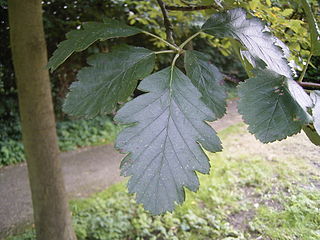
Scandosorbus intermedia or, formerly, Sorbus intermedia, the Swedish whitebeam, is a species of whitebeam found in southern Sweden, with scattered occurrences in Estonia, Latvia, easternmost Denmark (Bornholm), the far southwest of Finland, and northern Poland.

Hedlundia hybrida, the Swedish service-treeFinnish whitebeam, or oakleaf mountain ash, is a species of whitebeam native to Norway, eastern Sweden, south-western Finland, and locally in Latvia.

Karpatiosorbus admonitor, previously classified as Sorbus admonitor and also called the Watersmeet whitebeam, is a species of whitebeam tree found in Devon, United Kingdom. It is known only from the Watersmeet Valley at Lynton, with two stray plants growing on the coast above Sillery Sands, Countisbury. It has also been nicknamed the "no parking whitebeam" in some newspapers.

Karpatiosorbus devoniensis is known by the English name of Devon whitebeam and formally as Broad-leaved Whitebeam. When the fruit was reported as sold at Barnstaple Pannier Market the name French Eagles was used, apart from 1929 when they were reported as eagle-berries. When the trees were reported as seen growing wild on botanical walks they were referred to as French Hails. Broad-leaved white-beam, which was the common name until Devon Whitebeam took over, was used once in 1907.

Hedlundia thuringiaca is a widely cultivated species of ornamental shrub. It is cultivated by grafting.
Michael Charles Faraday Proctor PhD was an English botanist and plant ecologist, lecturer, scientific author based at the University of Exeter. He retired from his post as Reader in Plant Ecology at Exeter University in 1994.
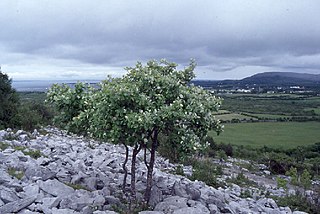
Aria hibernica, commonly known as Irish whitebeam, is a species of whitebeam endemic to Ireland. It occurs in most counties, usually as scattered individuals, or in small groups.

Aria porrigentiformis, commonly known as the grey-leafed whitebeam, is a species of whitebeam endemic to England and Wales.
Aria leighensis, commonly known as Leigh Woods whitebeam, is a rare species of whitebeam, a flowering plant in the|rose family Rosaceae.

Hedlundia is a genus of plants in the rose family. They are shrubs or small trees that have a hybrid origin involving crosses between Aria and Sorbus sensu stricto. There are about 48 species are distributed across central, western and southern Europe, Scandinavia, Turkey, the Caucasus, Crimea, and also central Asia. The term Hedlundia was published in 2017.















